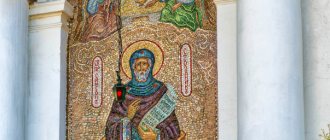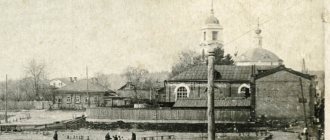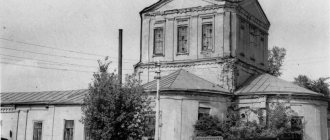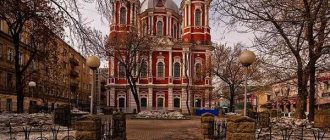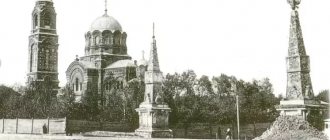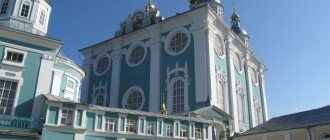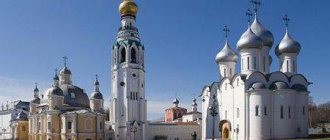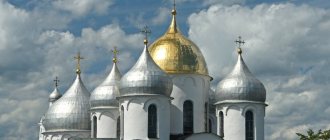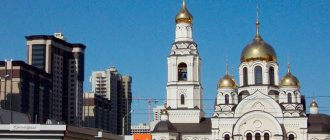The Church of Simeon the Stylite is a temple from the early 17th century, miraculously preserved in the center of Moscow. This white stone building against the backdrop of the Arbat high-rises looks quite small, one might say, like a toy. It's hard to believe that in the last century it almost became a victim of the construction boom in the center of the capital.
They began to dismantle the temple, the domes were removed from it and excavators were brought in. But it was not the chief architect of Moscow who saved the temple, but the restorer Leonid Ivanovich Antropov. He jumped into the bucket of an excavator and demanded that the temple be included in the List of State-Protected Monuments. The restorer did not leave the excavator until he saw the signed document placing the building under state protection. So he prevented an act of vandalism. It should be noted that through the efforts of Leonid Antropov, many architectural monuments of Moscow were saved.
The Church of Simeon the Stylite is a unique temple; many historical figures were married there, and famous Russian writers were parishioners. So, here in 1801, Count Nikolai Sheremetyev married the serf actress Praskovya Kovaleva (Zhemchugova).
Story
On September 1, 1598, the coronation of Boris Fedorovich Godunov took place in Rus'. According to legend, it was thanks to this event that it was decided to build the Church of Simeon the Stylite, whose memory was celebrated on the same day, September 1.
Simeon the Stylite is a Syrian monk who chose a special type of feat - continuous prayer on a “pillar” (in an open area, a stone). Simeon enjoyed great respect from believers from all over the area. He gave them advice and instructions. The Christian Church ranked the monk among the saints and established the feast of Simeon's Day in his honor, celebrated on September 1 (14).
The first church of Simeon the Stylite was built during the time of Boris Godunov. It was a wooden building, and documents from 1625 already mention a stone temple. The structure that has survived to this day was erected in the late 1670s under the Russian Tsar Fyodor Alekseevich Romanov.
The main altar of the temple was consecrated in honor of the Feast of the Entry into the Temple of the Most Holy Theotokos. The temple has two chapels, the first is Simeonovsky, the second, since 1759, Demetrius of Rostov (formerly St. Nicholas the Wonderworker).
The restoration of the church building took place in the 1960s, but after its completion, an exhibition of small animals was arranged in it, and then an exhibition of paintings was organized. In 1992, the building was transferred to the Russian Orthodox Church.
Church of Simeon the Stylite on Povarskaya
The Church of Simeon the Stylite on Povarskaya is an Orthodox church built in 1676-1679 in the Russian pattern style.
A wooden church stood on this site already in 1625: it is believed that it was consecrated on the day of the crowning of Boris Godunov, which fell on the day of Simeon the Stylite, a Christian saint, the founder of the pillar (a special type of feat is continuous prayer on the “pillar”), who spent 37 years on the pillar in fasting and prayer.
Tsar Fyodor Alekseevich ordered the construction of a stone church instead of a wooden one in 1676 . Over the course of 3 years, a small building was built with 5 domes, a bell tower, a refectory and two chapels - each with a separate apse and dome. Externally, the church looks quite simple, but elegant: the upper volume of the building is decorated with rows of kokoshniks, under which there is a carved frieze, and the bell tower looks especially impressive thanks to the arched openings and 2 rows of dormers with platbands.
The main altar of the temple was consecrated in honor of the Entry of the Most Holy Theotokos into the Temple, and the side chapels were consecrated in the name of Simeon the Stylite and St. Nicholas the Wonderworker (in 1759 it was reconsecrated in the name of Demetrius of Rostov).
Soviet years
After the Revolution, the church was closed and designated for demolition, having lost its chapters and the completion of the bell tower, however, it remained in a dilapidated state until the construction of the Kalininsky Prospekt (the future New Arbat). To prevent the old church from creating dissonance with the new high-rise buildings, they decided to demolish it, but the public managed to defend the temple.
In 1966, when the building almost collapsed, a large-scale two-year restoration began, during which the church was restored: crosses even appeared on the domes, however, they were almost immediately dismantled by order from above. After restoration was completed in 1968, the church building was transferred to the All-Russian Society for Nature Conservation, and it housed an exhibition hall of small animals and birds.
In 1990, crosses reappeared on the domes of the temple, and in 1992, after the collapse of the Soviet Union, it was returned to the Orthodox Church.
Over the years, the Church of Simeon the Stylite has become a popular wedding venue among the Moscow intelligentsia: Nikolai Sheremetev and Praskovya Zhemchugova-Kovaleva, Sergei Aksakov and Olga Zaplatina, Yuri Neyolov and Elena Nurenberg (the future wife of Mikhail Bulgakov), as well as many other famous people, were married here. One of the famous parishioners of the church in the last years of his life was Nikolai Gogol, who then lived on Nikitsky Boulevard: in February 1852, the priest of the church, Father Alexy, gave communion to the dying writer at home.
Today, the small white church is not the dominant feature of either Povarskaya Street or New Arbat, being in the shadow of the Novoarbat high-rises, however, it invariably attracts the attention of passers-by: against the backdrop of large-scale Soviet buildings, it looks like something exotic, but at the same time completely natural .
The Church of Simeon the Stylite on Povarskaya is located on Povarskaya Street, building 5 (at the beginning of New Arbat). You can get to it on foot from the Arbatskaya on the Filevskaya and Arbatsko-Pokrovskaya lines.
Description
The temple is famous for its architectural forms - it was built in the Russian pattern style and stands out for its rich decoration. The Church of Simeon the Stylite belongs to the so-called “fire” temples.
In ancient Russian architecture, temples richly decorated with triangular or pointed-up kokoshniks, reminiscent of flames, were called fire temples.
The main volume of the church building ends with a five-domed structure, which seems to grow from a hill of kokoshniks. Below there is a frieze, similar to a lace rim, made of bricks placed at an angle to each other.
Both chapels of the temple, united by a wide refectory, have their own apse and dome. The refectory is adjacent to the bell tower, which has arched openings in the lower tier. The temple has nine chapters - five above the main volume, three above the altars and one on the bell tower.
Restoration of the church building began in the early 1990s. The Church of Simeon the Stylite was painted again. Currently, we can see her shrine - the icon of St. Simeon the Stylite, preserved by the parishioners. While walking along Arbat, stop by this beautiful white stone temple with an unusual history. There are no crowds of tourists and it will amaze you with its stunning silence, intimacy and tranquility.
LiveInternetLiveInternet
Quote from Maya_Peshkova's message
Read in full In your quotation book or community!
Temples of Moscow: Church of Simeon the Stylite on Povarskaya
This small beautiful church is known to anyone who has ever walked onto New Arbat from the Arbatskaya metro station. It stands on the right, even side, and contrasts sharply, although in my opinion, on the contrary, it is in extraordinary harmony with the multi-story building standing next to it. Once upon a time, these lands were inhabited by artisans. Here, in Povarskaya Sloboda, lived the cooks, bakers and tablecloth makers who worked at the Sytny Dvor. The non-poor were considered to be people who could afford to build such a church.
The Church of St. Simeon the Stylite on Povarskaya is one of the oldest and most beautiful churches in Moscow
The Church of Simeon the Stolpnik on Povarskaya is an Orthodox church of the Central Deanery of the Moscow City Diocese on Povarskaya Street (on Novy Arbat in the city of Moscow), built in 1676-1679 by order of Tsar Fyodor Alekseevich in the style of Russian patterns.
A wooden church stood on this site already in 1625. According to one version, it was consecrated on the day of the crowning of Boris Godunov, since this day fell on the feast of Simeon the Stylite.
Simeon the Stylite
The stone church was built in 1676 by order of Tsar Fyodor Alekseevich (according to other versions - in 1679) in the Russian patterned style, with five domes, a refectory, a bell tower and two chapels, each with a separate apse and dome. Funded by the treasury of the tsar and Grand Duke Fyodor Alekseevich.
The main altar of the temple was consecrated in honor of the Entry of the Most Holy Theotokos into the temple, the other altar was consecrated in the name of St. Simeon the Stylite. Previously, the church also had the throne of St. Nicholas (since 1715), which in 1759 was reconsecrated in the name of St. Demetrius of Rostov.
The structure of the church is traditional: a hipped bell tower on the west adjoins a wide refectory with two single-domed aisles, and on the east there is a quadrangle with three altar apses. The main part of the temple was crowned with a five-domed structure resting on a hill of kokoshniks. The cornice attracts attention: it is made of bricks placed at an angle to each other. In the southern and northern walls of the church, several white stone tombstones from the 17th–18th centuries have been preserved - a reminder of the parish cemetery that existed here.
After the creation of the stone church, only one of the side chapels in the refectory became Simeonovsky. The main altar of the temple was consecrated in honor of the feast of the Entry of the Most Holy Theotokos into the Temple. Another chapel was originally Nikolsky, and in 1759 it was reconsecrated in the name of St. Demetrius of Rostov.
The history of the temple is amazing, but at the same time typical for most Orthodox churches. Its walls remember wars, revolutions, the abomination of desolation and rebirth from oblivion. They remember the wonderful priests and parishioners, among whom were both noble Muscovites and ordinary people.
Together with the country and people, the temple went through its way of the cross - the Napoleonic invasion and the fire of 1812; First World War; "renovationists"; closure and desecration in the 1930s; bulldozer tracks, under which he almost died during the construction of New Arbat; World War II; restoration in the 1960s; Finally, the return of the Church building in 1990 was a long, difficult restoration.
After the revolution, the church was closed and in 1930 was actually scrapped. Miraculously surviving, dilapidated, it survived until the construction of the Kalininsky Prospekt highway, and they were going to demolish it so that it would not introduce architectural dissonance with the high-rise buildings being erected, but through the efforts of the public they managed to defend it. V. A. Desyatnikov wrote in his book:
“The fact that this monument now adorns the avenue is not the merit of the former chief architect of Moscow and the author of the avenue, M.V. Posokhin. L. I. Antropov saved it for Moscow. When a powerful excavator arrived to destroy an ancient structure disfigured by perestroika, Leonid Ivanovich climbed into the excavator bucket and did not give the opportunity to work until G.V. Alferova and P.D. Baranovsky brought an order from the USSR Ministry of Culture to erect a monument on state security"
By 1966, the building was almost completely destroyed. In 1966-1968, it underwent a large-scale restoration, as a result of which the original shape of the roof was restored, even crosses appeared, which were cut off almost immediately by order of the highest authorities; The extensions and later elements that distorted the appearance of the building were dismantled, the cultural layer was removed to the level of the 17th century, and the area around the church was paved.
1960
The vaulted ceilings of the refectory, two tiers of kokoshniks and the main volume of the temple, the original shapes of window and door openings and their decorative framing were restored to their original form.
In the twentieth century, the church was threatened with complete extinction. They wanted to demolish it during the construction of the ridiculous New Arbat (remember, Muscovites immediately nicknamed it the “false jaws of Moscow”?), which ruined the magnificent appearance of the entire Arbat district. Representatives of the Moscow intelligentsia defended the church with incredible efforts.
In 1968, the temple building was given to the All-Russian Society for Nature Conservation, and it housed an exhibition hall of small animals and birds: guinea pigs, white rats, parrots, canaries, etc. The interiors of the temple were completely destroyed. In the 1990s, the temple hosted painting and folk art exhibitions.
In the film “Ivan Vasilyevich Changes His Profession”, in the episode where police and ambulance cars are going to a call, this church was included in the frame twice, and once its image was superimposed on the video. Noteworthy is the inscription “Exhibition” in large print on the sign in front of the church building
In 1990, crosses were again placed on the heads of the temple (by order of the deputy chairman of the Moscow City Executive Committee, Matrosov). In 1992, the Church of Simeon the Stylite was again given to the church and re-painted by young artists. It turned out that the temple icon of St. Simeon the Stylite, which was kept by the parishioners, had survived from the previous decoration.
Today the temple has returned to its former glory. The bell rings again and the words of prayer are heard. People come to the temple who, in times of universal worship of the golden calf, strive to live according to the commandments of Christ. In 2009, the 1050th anniversary of the repose of St. Simeon the Stylite and the 385th anniversary of the temple were solemnly celebrated.
SVT. DEMITRIY OF ROSTOV IN THE CHURCH OF SIMEON THE STILITE (ENTRANCE OF THE HOLY VIRGIN TO THE TEMPLE) ON POVARSKAYA
The exterior decoration of the church is simple and at the same time allows it to look very elegant. This is primarily achieved thanks to the upper part of the main volume with rows of kokoshniks and patterned drums under the small onions of the domes. Echoing them is the openwork tent of the bell tower with arched openings and two rows of “hearing” windows framed by platbands.
On the bell tower there were bells cast by master Fyodor Dmitrievich Motorin (1630-1688), the founder of the famous dynasty of foundry workers (lost in the 1930s). Under the rows of kokoshniks there is a wide carved frieze. The drums of the side chapels are also lavishly decorated. As was the case with many “fire” churches (the quadrangle of which was decorated with rows of kokoshniks), the tiered roofing of the Temple of Simeon the Stylite was replaced with a simpler and more practical hipped roof, and was restored only during restoration in 1966.
In 1812, the temple of Simeon the Stylite was plundered and severely burned during a fire. Valuables have been stolen. After the liberation of Moscow from Napoleonic troops, the parishioners of the temple, led by its rector Stefan Nikitich Popov, completely restored the church and the clergy’s possessions by 1818.
The altar in the present church is three-part, divided by two arches. In the right prealtarium there was a sacristy, in the left prealtarium there was an altar. The vaults in the altar lie on the walls. There are three windows in the altar and pre-altars.
The platform in the altar is one step higher than the temple platform. The two side altars are single-part, each with two windows, with semicircular vaults. All three altars are wooden, without elevations from the platform. The altars are square, in the real church - 1 1/2 arshins, in the refectory church - 1 arshin and 4 arshins.
The iconostasis of the new device, carved, made of wood, the carving is placed on a golden field in the visage of branches, stars, etc. The real church has a four-tier iconostasis. The royal doors, consisting of two leaves, are smooth, gilded, and covered in places with carvings.
The shape of the tops of the royal doors in the real church is straight, smooth, in the refectory - on some there is an image of a bowl, on others there are rays of figurative radiance. Iconostasis of the refectory church in three tiers.
The solea in front of the altar from one choir to another is made of stone, one step higher than the temple platform and is not separated from the latter by a lattice.
In a real church, the pulpit stands out from the salt and is made of white stone. There is no canopy over him. The choirs on one side are adjacent to the walls of the church, the other sides, the side ones, are made of balusters, the back ones are blank, with icons inserted into them. There are no special decorations in them.
FAMOUS PARISHERS OF THE CHURCH Nikolai Vasilyevich Gogol was a parishioner of the church at one time. He lived nearby, on Nikitsky Boulevard. For some reason, the neighboring boulevard is named after the writer. There, at the beginning of Prechistensky, which later became Gogolevsky, Boulevard, a monument to him was erected by the sculptor N.V. Tomsky, near whom Moscow “informals” for some reason liked to meet in the 1980s.
Tomsky’s sculpture, by the way, was erected in place of the previous one, erected in 1909 for the 100th anniversary of the writer, wise and ironic Gogol (the work of sculptor N.A. Andreev) and removed by order of Stalin. The irritating leader of the people, Gogol, was ordered to be melted down, and only by some miracle was this order not fulfilled. And in 1959, on the 150th anniversary of Gogol, St. Andrew’s sculpture was rehabilitated and installed precisely in that garden on Nikitsky Boulevard, which is adjacent to the house where Gogol burned the second volume of his “Dead Souls.” The priest of the church, Father Alexy (Sokolov), administered communion the dying writer in February 1852 at home. Before his death, he uttered his last famous words: “Stairs! Hurry up and give me the stairs!”
FAMOUS CHURCH WEDDINGS The temple was popular among the Moscow intelligentsia as a wedding venue.
Nikolai Petrovich Sheremetev and Praskovya (Parasha) Ivanovna Kovaleva-Zhemchugova, Countess Sheremeeva [ (July 20 [31] 1768, Yaroslavl province - February 23 [March 7] 1803, St. Petersburg) - Russian actress and singer, serf of the Sheremetev counts
On November 6, 1801, the secret wedding of Count Nikolai Petrovich Sheremetev and actress Praskovya Ivanovna Zhemchugova-Kovaleva took place here. The wedding took place in Moscow - away from the prim, high-society St. Petersburg, but still caused a lot of noise in high society. The daughter of the serf blacksmith Kovalev, Parasha, from the age of 7, was taken to the Sheremetyevo estate of Kuskovo to study theater skills. Singing lessons were given to her by the famous Elizaveta Sandunova, the wife of the famous comedian Sila Sandunov, later the owner of the main Moscow bathhouse.
The future countess was taught dramatic art by M. S. Sinyavskaya, an artist at the Medoxa Theater. The last time Zhemchugova played in the play “Samnite Baths” at the theater of the Ostankino estate near Moscow was in 1797. Her operatic talent was so great that it was said that she could take one of the first places among the famous singers of Europe. The owner of the serf theater, Count Nikolai Petrovich Sheremetev, fell passionately in love with the actress.
Sergei Timofeevich Aksakov
Here in 1816, the writer Sergei Timofeevich Aksakov and Olga Semyonovna Zaplatina, the daughter of Suvorov’s general Zaplatin and the captured Turkish woman, the beauty Igel-Syum, were married.
In December 1918, Mikhail Bulgakov’s future wife, Elena Sergeevna Nyurenberg, got married here with her first husband, Yuri Mamontovich Neyolov, the son of the artist Mamont Dalsky and adjutant to the commander of the 16th Army of the Red Army.
Elena Sergeevna Shilovskaya in 1928
And two years later, she separated from Neyolov and married the commander himself, Evgeniy Aleksandrovich Shilovsky (the prototype of Margarita’s husband from Bulgakov’s famous novel).
On August 1, 2005, Nikolai Karachentsov and his wife Lyudmila Porgina were married in the church. The sacrament took place on their 30th wedding anniversary. The wedding location was also not chosen by chance. Some episodes of the film “You Are My Happiness,” in which Nikolai Petrovich starred shortly before the accident, took place in the Church of Simeon the Stylite. His granddaughter Yanina was also baptized in the same church.
https://www.st-simeon.ru/
https://www.shigri.ru/izgotovlenie_ikonostasov/ikonostas_hrama_simeona_stolpnika_fragmenty.html
https://bolshoevoznesenie.ru/places/5243-cerkov-simeona-stolpnika-na-povarskoj/
